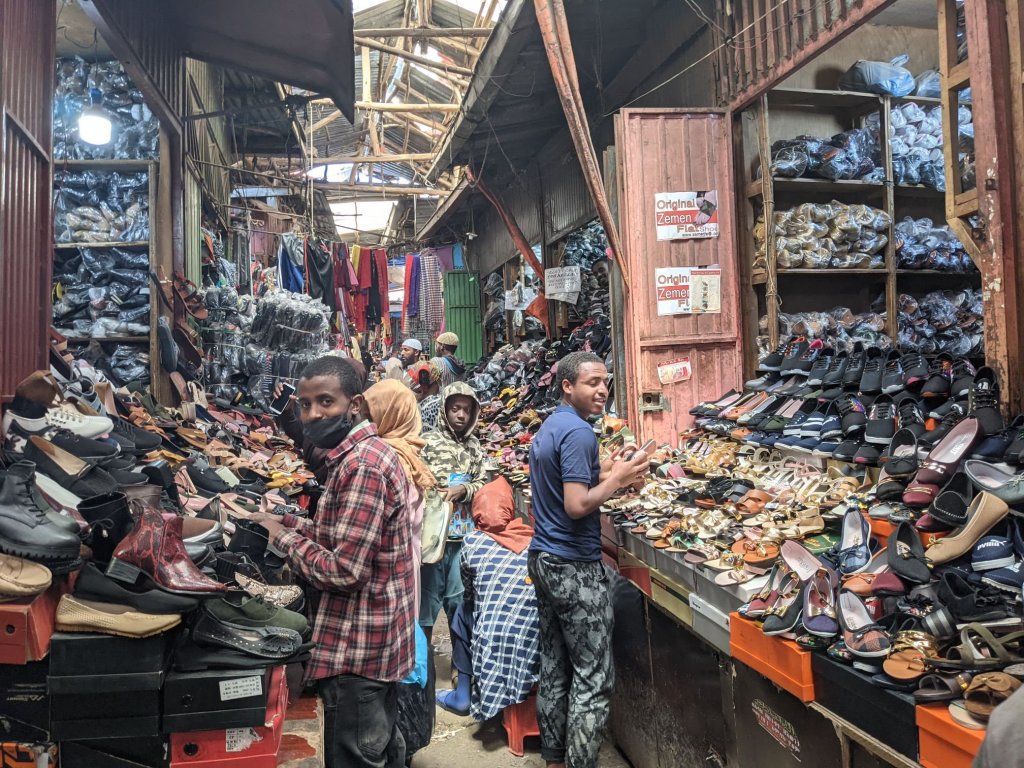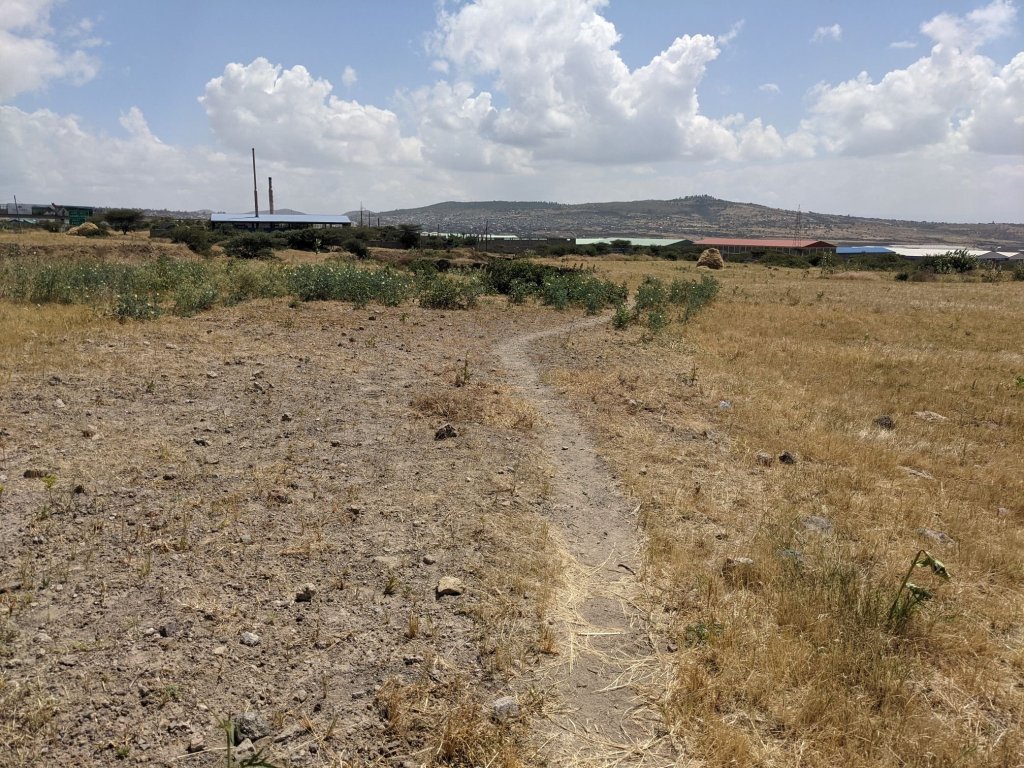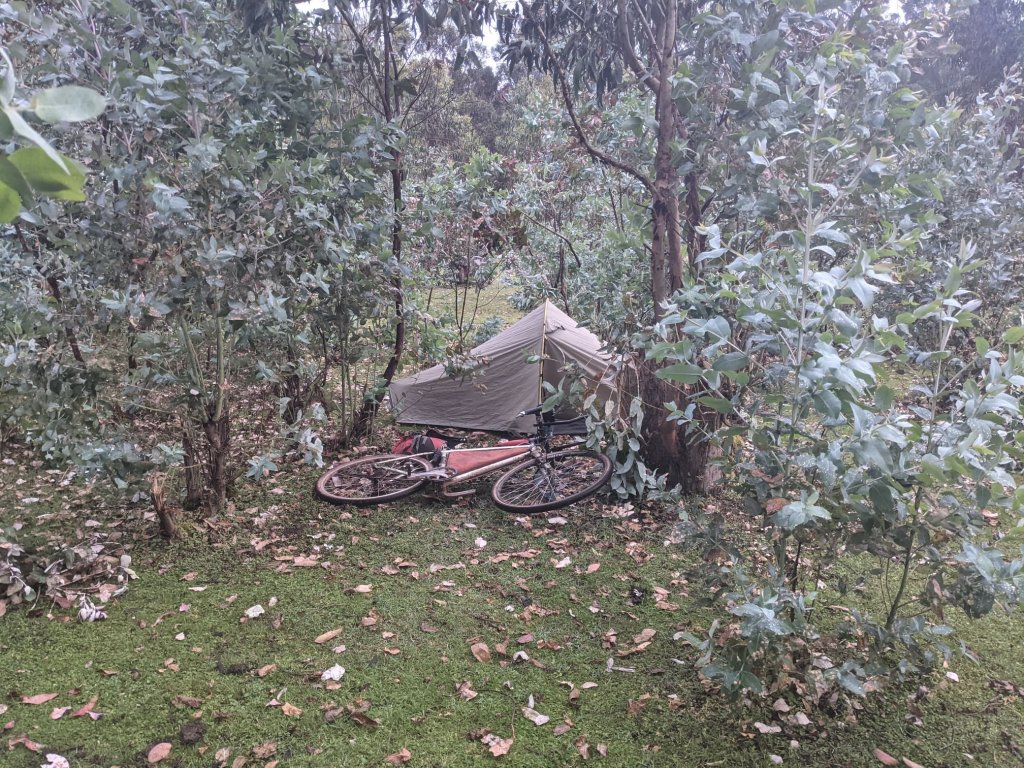It was a relief to arrive in Addis Ababa, the capital of Ethiopia. It was quite a contrast to Sudan. The area near the airport is quite wealthy, and there were all sorts of well-stocked shops (including lots of liquor shops). About half the people outside were women, in western style clothing – and barely a headscarf in sight.
It was dark when I left the airport so I took a taxi to a hostel. There was busy traffic and remarkably little use of car horns. We were stopped at a police checkpoint which was remarkably thorough. We had to get out of the car and be patted down, they went through my bag and checked in the space for the car tyre, under the boot. On the other hand my bike box on the back seat didn’t get so much as a second glance.
I arrived at the hostel and decided to upgrade to a private room for about £2 extra so that I could have somewhere to assemble my bike.
I didn’t get up to too much the next day, apart from readying my bike and gear. I went out for a walk to get a simcard and go to a supermarket, and it was nice not to be constantly sweating as I had been in Sudan and Egypt.
The day after that, I went out with Tracy (the woman I’d met at Khartoum airport) to see the sights of Addis Ababa. I took a taxi over to her hotel and from there we went on to the Mercado.
The taxi driver was a bit concerned about dropping us off there, and I’d read a bit online that it was supposedly rife with pickpockets. As soon as we got out of the taxi we were bombarded by people wanting to act as our guides, or sell us some fabrics. Declining their offers had no effect, but they did seem to go away when we straight up ignored them.

We walked around the market for a while. The area we’d been dropped off in was mostly clothes and fabric and we wandered around somewhat aimlessly until we reached some areas with other products.

A few times I noticed someone following us, and a couple of times people tried to steal from us, but they weren’t successful. At one point Tracy got her phone out to check a map, and lots of people warned her to be careful. One woman got upset, thinking Tracy was taking her photo, and was then very apologetic when I explained we were just looking at a map.
From there, we made our way over to the other side of town to try some Ethiopian specialties. First up was a coffee shop, to try the famous Ethiopian coffee. I don’t really drink coffee much so I couldn’t say if it was any good!
Next we went to a restaurant for Injera. Injera is a sour flatbread, served with a variety of toppings. What we ordered turned out to be a massive mixture of various curries, meats, cheese and, bizarrely, a slice of white bread.

We then went to visit a couple of cathedrals. The first one, Medhanialem Church, was quite impressive, though we didn’t go inside.

The second was more interesting. It was built to commemorate Ethiopia’s defeat of Italian occupiers. Two massive sarcophagi inside house the remains of the Emperor Haile Selassie and his wife. Lots of prominent Ethiopian politicians are buried in the cemetery.
From here it wasn’t far back to Tracy’s hotel. She was staying in the Sheraton which was incredibly fancy and had lots of quiet outdoor space, where we hung out for a couple hours – and had ice cream!

The next morning I set off cycling. I made it about 20 metres from the hostel before someone called out “Ferengi, fuck you.” Ferengi is the Amharic word for a white person, and it is a word I would hear hundreds of times during my time in Ethiopia, though usually without the added expletives.
I rode out of Addis Ababa, on roads relatively quiet thanks to the early hour. The urban sprawl continued on a while past the city itself. I stopped at a bakery for some piping hot fresh bread.
One of the benefits of cycle touring is you experience the slow, gradual changes in geography and climate. It was quite unusual for me to have this sudden change from cycling in the Sahara desert to cycling through green farmland, up in the mountains.

The weather was a big change too. The hottest it gets in Addis during the day is colder than the coldest it gets in Sudan at night! The wind is no longer so strong as to be such a defining part of the experience.
For the first half of the day I gradually descended. At the city of Adama I took a short cut on dirt roads. This led me past a rubbish heap which had the biggest vultures I’ve seen. Standing, they were over a metre tall, and had a wingspan of over 2 metres.


I saw a baboon there as well but it ran off before I could get a picture. I continued along these dirt roads but then the road I planned to turn onto turned out not to exist. I tried other roads but eventually gave up and went cross country, including climbing down I to (then up out of) a small ravine, before getting back to a road – a frontage road beside the motorway.


I then turned off onto another road, and began climbing back up, regaining the 800 metres I’d descended. I reached the town of Assela late in the afternoon. I checked into the first hotel, and got a room for 130 Birr (£2).
After a couple of hours, I was taken to someone who seemed to be in charge. He spoke a lot, in a way that emphasized his own sense of importance. He asked me lots of questions (about my “mission”) and at one point seemed to be saying that foreigners had to go stay in certain hotels. It seemed a bit late to be saying that now that I’d paid, unpacked, and been here two hours. He waffled on about security – “Here in Ethiopia we are all responsible for the security of our nation. The dog you see in the street is in fact the vanguard of our country’s security forces. And a cat too, why not?” Vanguard was a pretty impressive word for someone speaking a foreign language, to be fair. He claimed to have travelled all over Europe, “west and east,” and to speak Russian and French. He didn’t understand when I spoke Russian to him though, and his French mostly involved asking if I could swim. In the end I told him I was going to bed and I returned to my room.
I set off between first light and sunrise, and was surprised to find a lot of people out and about – I’m used to being the only one up at that time. It was under 10°C, and it was nice to feel cold for a change.
The next day started with rolling hills through farmland. I rode through one settlement, more a string of connected villages than a town. I saw lots of kids and teenagers on their way to school. I could see when I changed to a different school area as the colours of the uniforms changed – first bright pink, then blue.
Apart from the occasional small settlement, most of the people were farmers, living in small buildings with a few animals, surrounded by fields of crops.

I tried to take breaks in areas with as few people as possible. Inevitably though, someone would spot me, and come to see. Then others would come to see what he (and it was almost always men) was looking at. Before long there would be a crowd. It was similar to India, though not quite as bad.

Cloud cover stuck around for the whole morning, so it stayed pretty cool. It even drizzled occasionally, the most rain I’ve seen since Turkey.
Rolling hills turned into a sustained climb, bringing me up to an elevation of just over 3000m. A descent of course followed, down to 2300m or so. I passed through the occasional village, which always had crowds of people, very disproportionate to the size of the settlements.

Whenever people saw me, they would stare. Many would also shout at me – “you, you, you” being one of the more common shouts alongside Ferengi. There were also various unintelligible shrieks and whistles to try and get my attention. I generally ignored these. Some people greeted me with a wave, thumbs up or a call of “welcome.” These were the people who got a reply.
Another common shout was “China!” China lends a lot of money in Africa, and a common condition is that the money be spent on Chinese contractors. As a result the Chinese are often the only foreigners locals will have seen; and they can’t tell the difference between Europeans and Chinese.
Around the bottom of the valley I stopped at a river to collect some people water to filter. A group of people soon gathered around my bike, which I’m not a great fan of while I was away from it at the river.
I stopped shortly after to filter the water, and take a break. It took a while before any spectators arrived. The first one didn’t seem all there – he occasionally ran away to scream at a field, before returning to lie down about 50cm away from me and stare and giggle.

Unfortunately there turned out to be lots of thorns where I’d stopped and I ended up with a puncture in both tyres. By the time I’d replaced the first tyre there were 15 or so people staring at me, talking about me and laughing at me. I find this very annoying and I guess it flustered me because I accidentally put the punctured front tube into my rear tyre! I decided to just pump it up and ride on a few hundred metres before replacing it without a crowd.
Another hour or so brought me to a turnoff onto a dirt road. For the first few kilometres of this I rode through enormous fields of wheat, without anyone living in them. There was now very little traffic, and almost nobody out walking. I stopped for a break and the only people who spoke to me were just making sure I was OK.


I did pass through a village which was an exception. A lot of people laughed and shrieked wordlessly as I rode through, but it got quiet again past the village.
I’d hoped to find some uninhabited land toward the end of the day, and indeed as the road climbed farmland eventually gave way to woodland. I wandered off the road and set up camp.


Oct 31: 165 km
Nov 1: 152 km
Great read, much appreciated. Keep riding and writing!
LikeLike